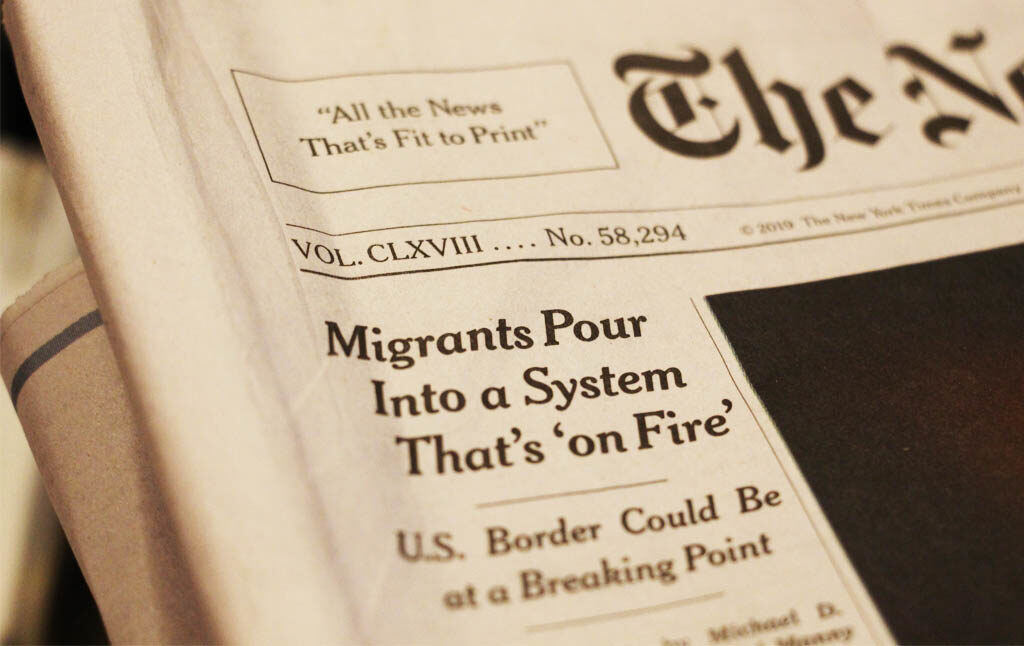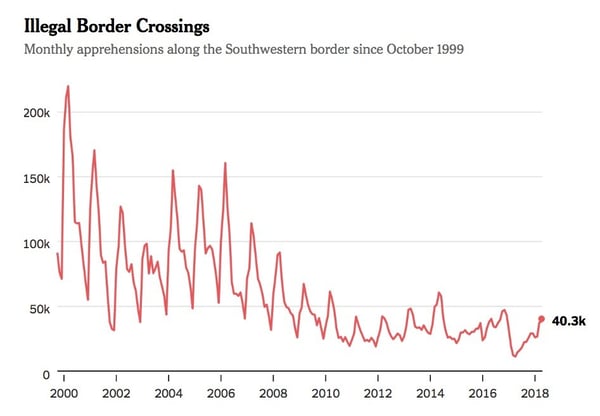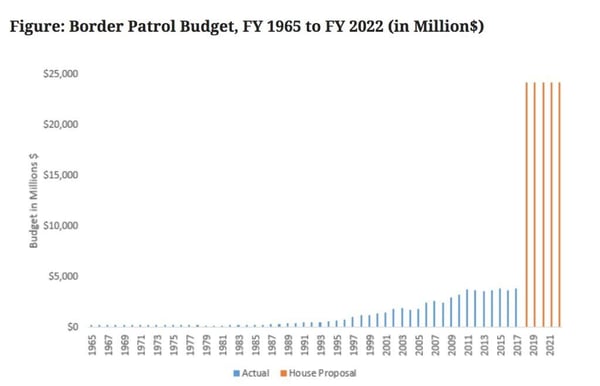
How To Create A Crisis
The New York Times repeats Trump’s narrative of an urgent border crisis that requires drastic measures…
Donald Trump’s argument for clamping down on immigration is based in part on the narrative that there is a “crisis” at the border. Something bad is happening, and it is urgent, and it must be stopped. Crises are emergencies, emergencies require extraordinary measures. We must build the wall to stop the crisis.
People on the left do not accept the idea that we need to Build The Wall—though there are some Democrats who could be sold on an environmentally-sustainable “smart wall.” But if the idea that there is a “border security crisis” is accepted, opposition to new Border Security Measures becomes more difficult to justify. Which is why it’s frustrating to find the New York Times’ news reporters pushing the false idea that there is a terrible unprecedented border security calamity and that hordes of disease-spreading migrants are pouring into our country at unsustainable rates.
The Times released a long report today entitled The U.S. Immigration System May Have Reached a Breaking Point, with the subtitle: For years, there have been warnings that America’s immigration system was going to fail. That time may be now. The thrust of the article is that there are simply too many migrants trying to come into the United States, and that there is a strain on our institutions and our capacity to police the border. It does not say explicitly that Something Must Be Done, but if you accept the article’s conclusions you will probably want Something to be done.
Let’s read for a bit, to get the general idea:
It was never like this before. The migrants come now in the middle of the night or in the bright light of day. Men and women arrive by the hundreds, caked with dirt, with teens and toddlers in tow… Tired and fearful, they look for the one thing that they pray will allow them to stay in the United States, at least for a while: a Border Patrol agent… The smugglers have told them they will be quickly released, as long as they bring a child, and that they will be allowed to remain in the United States for years while they pursue their asylum cases… For years, both political parties have tried — and failed — to overhaul the nation’s immigration laws, mindful that someday the government would reach a breaking point… That moment has arrived. The country is now unable to provide either the necessary humanitarian relief for desperate migrants or even basic controls on the number and nature of who is entering the United States… At the current pace of nearly 100,000 migrants each month, officials say more than a million people will have tried to cross the border in a 12-month period.
The impression you may have gotten from this is that having “more than a million people”/ “100,000 migrants each month” try to cross the border is something it has “never been like before.” It is indeed true that crossings have spiked over the last couple of months. This is not, however, something completely new. Here, from the Times’ own previous reporting, are the monthly numbers from prior years:

As you can see, not only are sudden spikes a regular occurrence, but the number of monthly apprehensions has gone well over 200,000 before. (Back when the Border Patrol had about half the staff and budget it does now.) The only reason the current number seems high is that crossings in the last few years have been so low. (Nor is there much of a qualitative difference between the present moment and previous high influxes. Here’s a substantially similar story from 2014.)
But an usually high number of crossings isn’t the crisis. The crisis, according to the Times reporters, is that we are exceeding our institutional capacity for immigration detention:
So crowded are border facilities that some of the nearly 3,500 migrants in custody in El Paso were herded earlier this month under a bridge, behind razor wire. In recent days, officials have grasped for ever-more-dire ways to describe the situation: “operational emergency”; “unsustainable”; “systemwide meltdown.” One top official said simply: “The system is on fire.” The immigration courts now have more than 800,000 pending cases; each one takes an average of 700 days to process. And because laws and court rulings aimed at protecting children prohibit jailing young people for more than 20 days, families are often simply released. They are dropped off at downtown bus stations in places like Brownsville, Tex., where dozens last week sat on gray metal benches, most without money or even laces on their shoes, heading for destinations across the United States.
First, I would hope that by now journalists would have finally learned that all-important lesson: “What anonymous government officials say” is not synonymous with “what the truth about a thing actually is.” Trump administration officials are not the ideal people to rely on for your supporting evidence that the system is overburdened.
In fact, there is reason to believe that when the Times says the government is “unable to provide” humane accommodations, the better term would be “unwilling to provide.” The Times asserts that crossings by families have reached such unsustainable numbers that housing is impossible, but the government is actually phasing out at least one family detention center and others are far from capacity.
Now, let me be clear: I am not saying more families should be “detained,” a euphemism for imprisoned. No asylum-seeking families should be imprisoned! We should reject the whole idea of keeping families locked up as they wait for court hearings, but the Times report suggests the problem is not enough prisons for immigrants (I’m sorry, “residential centers”), which is both false and also not the problem.
The Times report suggests that high recent numbers of crossings “have overwhelmed a system unable to detain, care for and quickly decide the fate of tens of thousands of people who claim to be fleeing for their lives.” These are asylum-seekers. They should be released into the country, just as if you flew to London and filed to receive asylum status, you should not be kept in the airport for six months but should be allowed to go find a hotel. “Unable to detain and care for” is a problem that need not exist if asylum-seekers are treated the way we expect to be treated ourselves on foreign travel. The Times says “families are often simply released” as if it’s a bad thing. Again, imagine how absurd this would sound if you or I went to Canada: While they were awaiting a judgment from the Canadian courts, they were simply allowed to pass freely through Canada and even stay in it. That’s what a sane country would do! Keeping people in prison while you decide their immigration status is irrational and inhumane!
Also, note that phrase “quickly decide the fate of.” Hang on a minute. Most of these people aren’t going to get lawyers. For the ones who do get lawyers, it will take a lot of time to prepare their case. Why should deciding their “fate” quickly be the goal? Consider the risks here: Asylum-seekers are claiming that they will probably be murdered if they go back to their countries. You do not want to risk getting this judgment wrong. One wrong call and a person could end up dead in the trunk of a car within days.
The cases take a long time to process, sure, but it’s not clear what the actual problem here is. (On the other hand, it’s very clear what the problem would be if you sped up the asylum docket and encouraged judges to make snap decisions.) Donald Trump says the United States is “full,” but the Times’ previous reporting has made it clear that the opposite is the case: Parts of the country really need more people.
Repeatedly throughout the article, the New York Times reinforces the stereotypes that Donald Trump would like you to believe about migrants. Note the phrase “caked with dirt” at the beginning, and then the following truly icky passage:
“The majority of our agents get sick. Infectious disease is everywhere,” Mr. Cabrera [a Border Patrol union official] said, including in the Border Patrol’s migrant processing center. “There’s always scabies in there. Usually we have chickenpox. We have tuberculosis in there. You name it, it’s probably been through that building. So it’s dangerous. It’s dangerous for our agents. It’s dangerous for the detainees that don’t have anything.”
Now, I don’t actually doubt that a lot of people in these facilities are sick—they’re being confined closely together in deprived conditions. But there needs to be evidence provided before we conclude that this is a result of the “inability” to provide care rather than the negligent failure to provide care.
How about this bit?
Experts say the president is not wrong when he says that “legal loopholes” in America’s immigration system are partly responsible for encouraging migrants to bring children like Jeremias on a dangerous journey that in some cases ends in tragedy. In December, two migrant children died in Customs and Border Protection custody after becoming gravely ill during their trip.
It’s not clear which “experts” they’re talking about, other than the Border Patrol union official, or for that matter what the “loopholes” are. Is the loophole that children have to be released from detention after a certain amount of time? That people get to apply for the basic asylum protections offered by international law? The Times here suggests asylum-seekers are sneaky loophole-exploiters rather than people with genuine fears. And we have a complete acceptance here of the narrative that when children die in Border Patrol custody, we should blame our lax immigration laws for encouraging them to come in the first place.
There are other infuriating parts of this article. The Times says that the “president has not chosen to prioritize a surge of new resources to the border,” without making it clear what resources it is talking about. (More “residential detention centers”?) The Times says Trump’s “repeated denigration of Mexico over the years… risks undermining Mexico’s willingness to help to keep Central American migrants from traveling to the United States,” which assumes that, like Donald Trump, we all want Mexico to take an active role in blocking asylum-seekers from coming here. There are all kinds of implications scattered throughout that asylum-seekers are liars exploiting the system, from the “loophole” stuff to sentences like: “They have learned how to make asylum claims, just as the law allows them to do.” The Times refers to “the Constitution, which the courts have decided protect migrants as well as citizens,” which is really not the case: Citizens get bail hearings if they’re detained for too long, but the Supreme Court has decided that migrants do not. The Constitution applies to some degree, but it’s essentially a different Constitution when you’re not a citizen.
I find this article exasperating because it regurgitates propaganda. It leaves you with a number of false impressions: It suggests that migrants are disease-ridden and sneaky, that the U.S. is extremely generous in “caring for” them and grants them full legal rights, but that they exploit “loopholes.” To the reporters’ credit, there is a passage in which they interview several migrants and get their side of the story. But they do not show anywhere near the degree of skepticism that you need for claims by Trump administration border officials. They say there’s a crisis and that their hands are tied. But what’s the evidence for that? What is the evidence that there is any kind of actual problem here?
It should be obvious why this is important. It is important because the crisis narrative is going to be used to justify diverting large amounts of money from domestic spending programs to militarizing the border. These are the kinds of Border Patrol budget increases that factions on the Congressional right have been proposing: 
This is madness. Unfortunately, the New York Times, which has previously done good work debunking claims of a crisis, has also proven itself willing to print Trump administration Premium-Grade Bullshit about the bogus Crisis that requires immediate new measures for tough border security. Democrats who read the New York Times will themselves get on board with the “security now” narrative. And we will vastly expand the scope of the nation’s already-bloated security apparatus, imprisoning many more people who have committed no crime.
This is a good demonstration of how the press ends up taking us down the road toward horrors. I have previously documented the New York Times‘ pitiful 1920s and ’30s failure to report accurately during the rise of Hitler and the onset of the Holocaust. They have learned nothing. They are, to use an industry term, credulous fuckwits. And there are real human consequences to badly done reporting like this.
I am grateful to Brianna Rennix for explaining to me what is actually going on at the border. Brianna works with asylum-seekers every day and her writing is an invaluable guide to the actual facts and human realities of the immigration system.
If you appreciate our work, please consider making a donation, purchasing a subscription, or supporting our podcast on Patreon. Current Affairs is not for profit and carries no outside advertising. We are an independent media institution funded entirely by subscribers and small donors, and we depend on you in order to continue to produce high-quality work.





